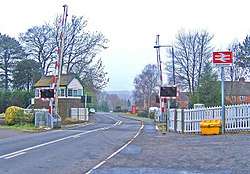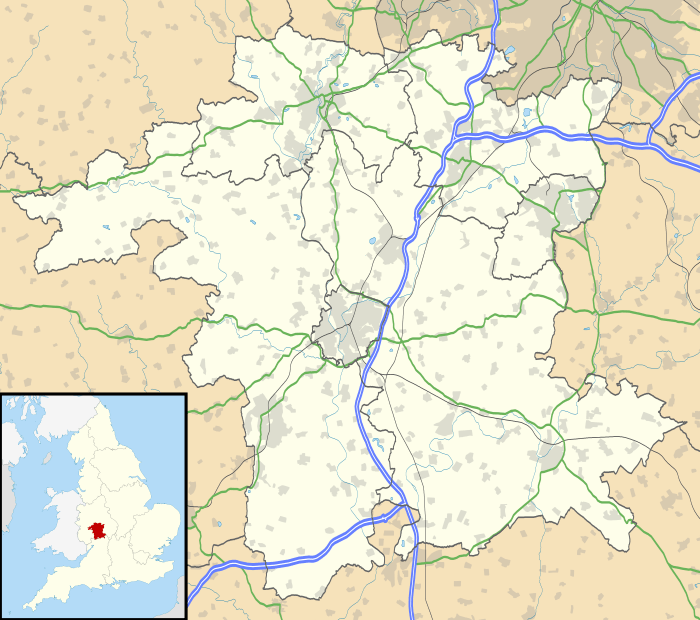Blakedown
| Blakedown | |
|---|---|
 Blakedown Station and Signal Box on Mill Lane | |
 Blakedown Blakedown shown within Worcestershire | |
| Population | 1,556 [1] |
| OS grid reference | SO879784 |
| • London | 108 miles (174 km) |
| Civil parish |
|
| District | |
| Shire county | |
| Region | |
| Country | England |
| Sovereign state | United Kingdom |
| Post town | KIDDERMINSTER |
| Postcode district | DY10 |
| Dialling code | 01562 |
| Police | West Mercia |
| Fire | Hereford and Worcester |
| Ambulance | West Midlands |
| EU Parliament | West Midlands |
Blakedown is a village in the Wyre Forest District in the north of the county of Worcestershire, England. Due to its road and rail links it serves mainly as a dormitory village for Kidderminster, and the cities of Birmingham and Worcester. Originally part of Hagley Parish, it was transferred in 1888 to the small adjacent parish of Churchill, which became Churchill and Blakedown.
Development
Much of Blakedown was originally an area of common land, enclosed in the 19th century. However Harborough Hall, which once belonged to the family of William Shenstone the poet, is probably the successor of a house that goes back to Mediaeval times. William Shenstone wrote some of his works whilst staying there.[2] With the coming of the railway line and station in the mid 19th century, Blakedown began to grow into a village, eventually becoming larger than its companion, Churchill.
The main road that runs through the village was part of the turnpike road from Birmingham to Kidderminster. When the turnpike trust was established in 1753, Blakedown was the location of one of the toll gates, the other end of the section being located near Halesowen; both toll houses still survive.
Blakedown railway station was opened in 1852 and originally called Churchill station). Later it was called Churchill and Blakedown before adopting its current name. The modern village of Blakedown is effectively cleft in half by the railway line, though the greater part of the village situated north of the line was built afterward. The old signal box at the level crossing was shut in 2012 but was then acquired by the Churchill & Blakedown Historical Society for their headquarters and was shifted across the road to a site adjoining the station in 2016.[3]
The village has a small church, St. James the Great, designed in 1866 by Gothic revivalist George Edmund Street; behind it is a Church of England primary school. Long standing businesses such as the village butchers, newsagent, grocery and service station/garage have closed, though a Post Office/General Stores still services the village. There are also two inns, The Swan and The Old House at Home.
Blakedown is well known for its Nurseries and the first Gladstone apple was grown there in 1868.[4]
Sports facilities
Blakedown has excellent sports facilities, including its own golf club which was originally a 9 hole course, now extended to 18 holes. Other sports facilities include a tennis club, football and cricket plus a snooker club which was established in 1904. Former World Billiard Champion and local resident Rex Williams is the club's president. A new outdoor bowling green was completed in 2016 to compliment indoor bowling held in the village hall. Blakedown also has a small sports car business and equine facilities.
Water mills
The Wannerton Brook and its tributaries running across the civil parish have been dammed to form chains of attractive pools. The boundary changes of 1888 united the metalworking mills once sited on these in the newly created local authority. They included Stakenbridge Forge, a spade and shovel mill, where gun barrels may also have been manufactured during the Franco Prussian War, and the ancient Churchill Forge Mill which served many West Midlands conurbation industries during the 19th and early 20th centuries. Two tributaries to the Wannerton Brook also included industrial mills: Spring Brook Forge in Blakedown, which was both a glass works and later an ironworks; Blakedown Foundry on the Kidderminster Road; and the adjoining sawmill which also made iron products earlier. There were also corn mills at Harborough Hall and on the Churchill boundary.[5]
References
- ↑ 2001 Census census
- ↑ A History Of Churchill and Blakedown by E. J. D. Swabey 1976
- ↑ Kidderminster Shuttle, 24 October 2016
- ↑ A History of Churchill and Blakedown 1976
- ↑ Watermill Sites in North Worcestershire, Hagley Historical & Field Society 1993, pp.30-35
External links
| Wikimedia Commons has media related to Blakedown. |